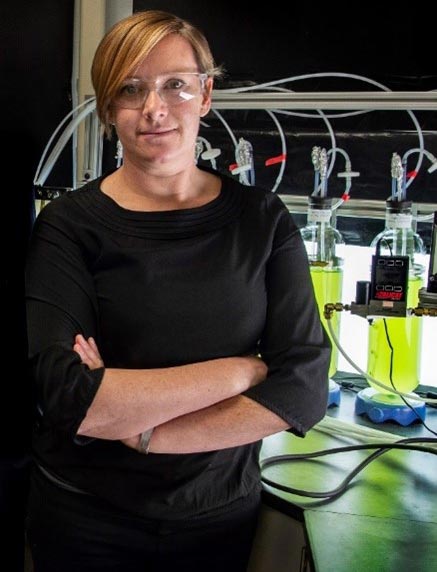With NREL's Feedstock Research, Algae and Garbage Could Be Ingredients for Zero-Emissions Fuels of the Future

Scientist Lieve Laurens stands in one of NREL’s algae labs, which provide a critical capability for studying the genes and metabolism of algae. Laurens is among four NREL researchers leading the feedstock research. Photo by Dennis Schroeder, NREL
In theory, over 1 billion tons of biomass could be sustainably collected and processed into biofuels by 2030 in the United States, according to U.S. Department of Energy analysis.
But turning that theory into practice hinges on improvements in how biomass is grown, collected, and processed. This is especially true for emerging feedstocks like municipal solid waste (MSW) and carbon-dioxide-eating microalgae—both promising ingredients for making net-zero-emission biofuels and bioproducts.
The National Renewable Energy Laboratory (NREL) is helping unlock the full potential of the U.S. feedstock supply after receiving over $2 million from the U.S. Department of Energy Bioenergy Technologies Office (BETO).
Used for two projects, the funding will support NREL scientists and partners studying how to best grow photosynthetic algae and efficiently sort municipal solid waste, important steps for making both feedstocks more economical.
"Algae and MSW have unique potential as biofuel feedstocks—carbon sequestration and broad waste reduction," said Zia Abdullah, laboratory program manager for NREL's BETO-funded biomass research. "These two projects will lower key barriers to scaling up the use and affordable production of these promising resources."
Making biofuel from algae and MSW presents unique logistical challenges. For example, farmers must expertly grow algae in large outdoor ponds, where the organisms are exposed to a range of weather conditions. The algal biomass must then be harvested and processed to generate the fuel-feedstock. A key challenge with MSW, on the other hand, is quickly sorting and processing its jumble of glass, metal, plastic, food waste, and other materials that are thrown in the trash.
Today, over 50% of MSW is sent to landfills across the country. This project aims to overcome a primary barrier for transforming that waste into a resource for making sustainable fuels and chemicals: quickly characterizing and sorting the many materials that comprise MSW. A team of NREL researchers, led by John Yarbrough and Ashutosh Mittal, along with partners at North Carolina State University, the town of Cary, and IBM, will develop and demonstrate an open-source, freely available, and fully functional smart MSW management system.
The novel sorting system will utilize a combination of spectroscopy, computer vision, and machine learning to rapidly identify, characterize, and provide informed decisions on the overall quality of different MSW materials, including determining their calorific value. This work will ultimately allow the AI-driven smart MSW management system to be coupled with commercially available robotic systems, allowing for proper redirection of the organic fractions of MSW (food, plastic, paper and paperboard, rubber, leather, and textile) in real time at multiple conveyer speeds to the appropriate conversion-ready feedstock destination.
Major Participants: North Carolina State University, NREL, the town of Cary, North Carolina, and IBM Inc.
Cultivating Algae Outdoors Using Passive Direct Air Captured Carbon Dioxide
Scientists are increasingly interested in using photosynthetic microalgae to capture and store greenhouse gases, such as carbon dioxide (CO2), from the atmosphere. However, today's algae farms must be supplemented with cheap, steady streams of CO2—often from nearby powerplants or fuel refineries—and delivered so far in excess of algae ponds' capacity that efficiencies are often less than 20%. A team of scientists aims to improve the capture and storage efficiency of CO2 by coupling algae cultivation as photosynthetic and biocatalysis systems to a mechanical tree harboring a passive direct air capture unit.
To maximize the uptake of CO2, the NREL team, led by Lieve Laurens, will study mechanisms for increasing carbon capture and storage efficiency of algae using biological, engineering, and analysis approaches. In concert with techno-economic and life-cycle analysis, the NREL team will study the diet of a highly productive algae species to understand how it might be engineered to better store the greenhouse gas as cell biomass, as well as develop novel CO2 delivery approaches in combination with the introduction of a highly effective carbonic anhydrase protein.
Major Participants: Arizona State University, NREL, and Silicon Kingdom Holdings
Learn more about NREL's bioenergy research.
Last Updated May 28, 2025
